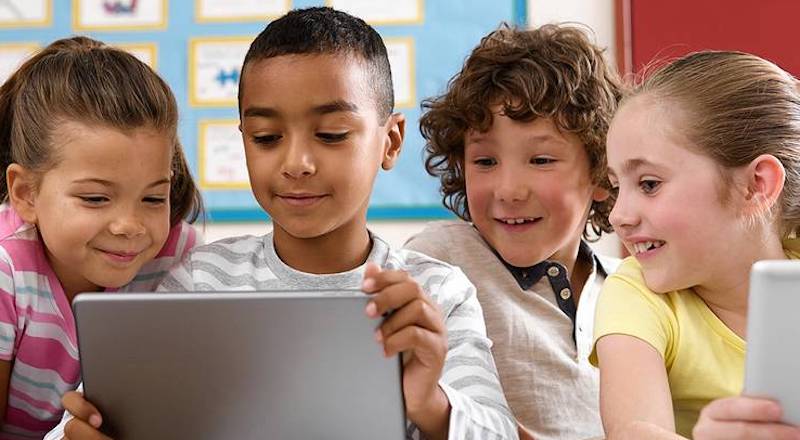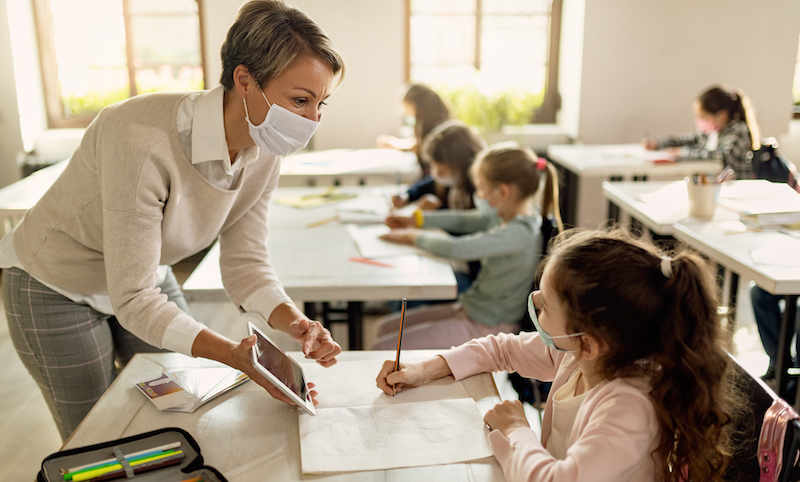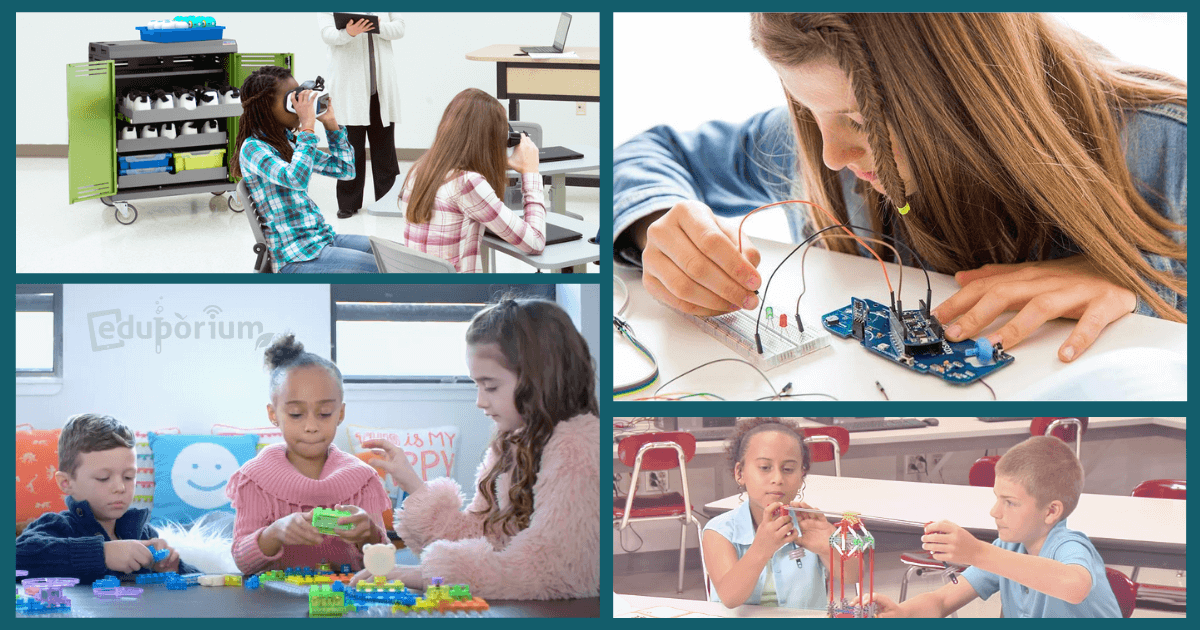After pushing through a year of changes and uncertainty, teachers are preparing to welcome students back to school buildings. Hopefully, safety measures will be minimal, but that's not the only change students will notice. Throughout the remote learning era, for better or worse, they've relied on technology to connect, communicate, and access educational experiences. That's largely why educators, administrators, and parents are wondering about technology's role as students start returning to normal. On one hand, they may want to build on momentum students have developed and allow them to continue bolstering their tech skills. On the other, educators may want students interacting with peers as much as possible. So, EdTech use levels after the pandemic may come down to individual situations.
Pandemic EdTech Trends That Might Stick Around
Some educators might hope to do away with the technology they've spent the last year staring at. Administrators, however, might not be so quick to move on from it. While we can almost all agree that face-to-face learning and traditional classroom experiences are the best ways to serve students, it might be wasteful to completely throw away every experience from distance learning. Some educators may want to keep new approaches in place even when they return to the classroom full time. Teachers and students have used so many different EdTech tools up to this point. Whether that's a learning management system, multimedia creation platform, or communication channels, these experiences could serve as a great foundation for helping students build additional digital age skills.
Using flexibility to your advantage.
One of the EdTech trends that may become permanent is flexible learning. This can take one of (at least) two directions in terms of its definition. It may include either flexible classroom design or flexible tech solutions. Teachers have seen that students can learn in different situations and that they're able to adapt to new environments. As long as tech solutions are portable, there's no reason to move away from this upon retuning to the classroom. Plus, with students more used to using a device for learning, flexibility in instruction could increase as well. On the flip side, however, more devices in play leads to the need for more power. This means that school and district leaders will have to consider power requirements as well as Wi-Fi strength for the optimal learning experience.
It starts with the infrastructure.
Ideally, teachers (and even students) will be adept at identifying issues with EdTech tools more efficiently. School tech personnel will also likely be more adept at quickly providing solutions. Rising demand for efficient connectivity has also likely led to network revamps in many schools. Besides cost, technicians have also gone through additional training to help identify these issues, which hopefully helps reduce response time or helps everyone avoid them altogether. Finally, with more familiarity with the cloud, educators can structure lessons in the most efficient way. This also provides a solid back-up plan in the event educators need to pivot back to remote learning. Having files and lessons stored in a cloud environment can allow learning to continue if it's disrupted again—a positive that's come out of this whole experience and another trend that may have become permanent.
New EdTech Focal Points in the New School Year
Once school leaders are able to truly focus on life after the pandemic, many of them will start with re-evaluating technology. There's no doubt that, along with social-emotional learning, applying what everyone learned during the remote learning era is crucially important in terms of technology. Access and equity are two things at the top of the list of priorities. Since we saw first-hand how much we could come to rely on technology, the infrastructure needs to be in place, ready to activate, and able to reach every student. Though teachers and students will eventually be able to return to normal learning situations, it could be detrimental to ignore what we saw over the last year.
EdTech investments and accessibility.
Like we alluded to, one of the key focal points will be surrounding digital access. Without all students being able to access devices in and out of school, the frustration of the digital divide remains in play. Plus, with students coming off an untraditional school year and then summer, 'slide' conditions could definitely come into play. Technology, of course, can be a valuable tool in welcoming students back to a stimulating learning environment. At the same time, school and district leaders must quickly decide what to invest in. In many cases, it might be best to focus on simplicity. Acquiring technologies that teachers already know and are comfortable with can certainly wind up being more cost-effective in the long run.
Teacher training and commitment to innovation.
Another thing that administrators want and teachers need is adequate technology training. In order to continue using technology effectively upon returning to school, this training is key for many teachers. In fact, it's a top necessity for ensuring the success of technology rollouts in the classroom. Besides that, embracing new approaches will be key for classroom teachers. Many new strategies evolved in the last year and carrying over what works while also seeking classroom-specific solutions will help. Since educators relied so much on technology throughout the pandemic, those innovations will likely stick around. And, because of that, they may only become more successful with in-person use and teacher training.

What Teachers and Students Need from EdTech
There are many different types of educational technologies but, in our eyes, there are two main groups. These include hands-on tech tools, like those often found in a STEM lab or makerspace, and those of the digital variety. Both are equally valuable to students and teachers and provide them different sets of benefits. As we hope all students return to their schools in the fall, there will undoubtedly be a mixture of these types of technologies. Digital tools will stick around, in our opinion, because of how we've seen them affect instruction throughout the pandemic. Then, on the other hand, educators may also be craving the chance to create active experiences for students using STEM tools.
What are teachers looking for from EdTech tools?
Teachers and students, logically, may want and need different things from EdTech tools. Since so much of emergency learning involved attempting to keep relationships and connections intact, this is one factor. Kids also crave the opportunity to learn and explore with their friends in the classroom. In order to make up for a lack of these collaborative experiences, teachers may benefit from incorporating any type of STEAM solution that helps advance student collaboration. Since budgets may also come into play, however, they'll have to make sure these tools are worthwhile investments. Then, there's still the long-time requirement of making sure students are safe and secure while using them.
Tech solutions with multiple dimensions.
Finding EdTech solutions that are equitable, secure, and engaging may seem like a tall task. Of course, if you know where to look, however, it becomes much easier. Depending on the age of students, concepts being taught, and school budgets, we're confident that there's something helpful for everyone. Take robotics and coding kits, for example. Not only are they great for helping students practice coding, they also help promote collaboration, communication, and problem solving. For teachers, pairing them with a classroom management system, like Class Connect, can make them much more valuable. It will be key to identify where students are at in terms of STEM skill development when they return to school. This way, educators aren't overwhelming them with too much too soon—this is why the right EdTech tools can help ensure everyone is comfortable with what's expected.
Top EdTech Must-Haves Moving Forward
There's no question that educational technology has evolved over the course of the pandemic. It's no longer enough to give students and teachers a random assortment of technologies and send them on their way. EdTech tools—both physical and digital—need to be equipped with certain features and enable certain types of learning experiences. At the top of that list is inclusivity. We now know how important it is to give students equitable access to learning opportunities and that this is not always the case. Educators also need this support amplified in many cases when it comes to students in low-income areas and English language learners. Basically, we need a system-wide assurance that technology can help every student progress.
The best features of learning technologies.
In addition to accessible technologies, students also need consistent access to high-quality resources. One of the most reliable options is open educational resources (OER). These tools can typically be personalized, refreshed, localized, and flexible enough so that students can utilize them from anywhere and continue to do so as situations evolve. On the other hand, in order to make technology-based learning more equitable, students need to be provided with a good experience. Presumably, access issues will be improved when kids return in the fall, but tech solutions also must be teacher- and student-friendly. For administrators, this means evaluating solutions based on how students actually use them and keeping human-centered values in mind.
Allowing for interactive experiences in the classroom.
Another feature to keep in mind is evidence-based examples of success. Administrators might be better off turning to EdTech solutions with proven research and results backing their use in educational environments. Those with established reputations and increased engagement associated with them will often be best. Finally, even when trying and researching different EdTech tools, it's vital to remember that they should ideally promote interaction. Students are going to need and crave socialization upon returning to schools. Whether it's among classmates or between students and teachers, EdTech solutions that foster hands-on, inquiry-based experiences could also prove to be effective.

VR and AI Could Be on the Rise
EdTech isn't limited to the tools students use to improve learning outcomes and engagement. Teachers and administrators can benefit from it, too. To wrap things up, let's explore how two of the most intriguing and powerful modern technologies—virtual reality and artificial intelligence—could wind up becoming much more prominent in the months following a return to normalcy. Starting with VR, educators may be looking for a robust and immediate way to ramp up engagement. Many virtual reality systems allow for this and help teachers bring learning to life. Lessons are often exploration-based and can afford students the long-awaited opportunity to truly interact with something meaningful.
How artificial intelligence may help.
There's also AI-based tools that could make a serious impact. Some educational leaders leveraged the insights gained from artificial intelligence applications to better support students while teaching and learning remotely. The same can be done once they return to school. Each student is likely to be in a different place mentally, socially, and academically. AI tools can help educators make these determinations and subsequently provide them with the proper support. In order to provide that optimal support, data-driven decisions, including when it comes to choosing EdTech tools, are very valuable. AI can help teachers personalize instructional content and the hands-on experiences students participate in, increase accessibility, and help students improve retention.
Making the most out of in-person learning.
Some students may need time to readjust when they return to a physical classroom. Especially for young children, they may have unlearned what it means to be physically and mentally present with their classmates and teachers after over a year of being away from them. Many other students also have trouble focusing in general. With the technology tools we've talked about, educators can help curb these issues—only if even a little bit—and provide relevant academic and social experiences for all students. It definitely would take some research and developing a sound implementation plan, but the technologies are there if educators are willing to explore them for the sake of their students. We might not be able to return to a completely normal learning experience for some time, but we definitely can try to enhance it as much as possible.
For the latest EdTech, STEM, and 21st century education news, follow us on Twitter and Instagram. Like us on Facebook, too, or sign up for our newsletter for our latest product announcements and offerings. If you have an idea for an Eduporium Weekly theme, send us a message on social media or comment below.



